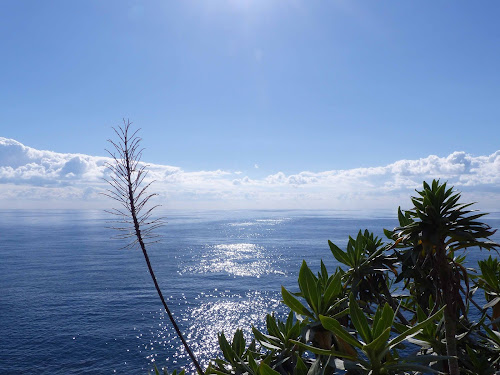As those who know me would predict, first up on my things to do was to find out more about the main textile feature of Madeira - embroidery. A product admired by many on visits to this magical island, it is all too easy to overlook the considerable skill and hours of work required to produce the exquisite hand embroidery that Madeira is well known for.
With a little research before my visit, I knew just the place go in Funchal to find out more. Bordal is one of the main producers and exporters of fine Madeira embroidery and they have two shops in the centre of Funchal. I visited the shop and factory premises at Rua Dr Fernao Ornelas 7 - just over the road from the main market. I was greeted by friendly shop assistant Sandra who explained about the quality of the work and how their embroidery is still all hand stitched on the island.
Bordal offers free short tours of their factory premises above the shop where you can learn about the end to end process. The first stage is the embroidery design, drawn in charcoal on paper and honed to the designers satisfaction - this requires immense skill in its own right. Then a calculation of the number of stitches is made using a device called a curvimeter. All the lines to be stitched are traced and the resulting distance is converted into the number of stitches!
The lines on the paper design are then perforated with a pedal powered machine - another of the skills in the embroidery process which takes many years to become fully competent in.
Once completed, the perforated sheet is then used to transfer the design to fabric. The pattern sheet is placed on top of the fabric and a mixture of indigo, oil and wax is spread across the pattern sheet and pushed through the perforated holes on the paper design with a wooden block.
The Bordal factory operates an outworker system with more than 400 embroiders across Madeira, who collect their work from the factory and return once complete. Monies are paid after the completed work has been quality checked and the amount is based on the number of stitches made.
Bordal holds thousands of paper designs, many of which are traditional made with white thread on white fabric. When designs are in colour, the pattern sheet is coloured by hand with a key for the embroiderer to work from.
When embroidery work is complete, then comes the all important business of removing the indigo dye, either in a large washing machine or by hand where the work is delicate.
And last of all to pressing the completed pieces, a task best done on damp fabric as anyone who has ever ironed linen will know.
It was sad to hear, although not surprising, that this traditional hand skill has no new generation of embroiderers coming through. I guess in a fast moving world there is little appetite to learn a time hungry hand skill, even to make desirable contemporary products like this exquisite table linen.
The table displays made by major hotels with Bordal table linen were just stunning this year and I visited twice to be sure that I had taken it all in!
There are so many striking things to look at in Funchal at Christmas and the main market was another venue packed with colour. Shopping there for Christmas food was a very exciting experience.
And is course there were colourful Madeira flora aplenty, and poinsettias were the stars of the Christmas displays.
Funchal made for magical night strolling too, with the little food stalls of 'Mercadinho de Natal' and twinkly light displays in abundance.
My most surprising find in Funchal was the Artes Portas Abertus project, where in 2011 artists began to revitalise doors in the old town with all manner of paintings. I enjoyed a many hours looking at and photographing this tremendous art work in and around Rua de Santa Marie; and the Christmas period was a great time for this, as many of the doors which belong to shops and restaurants were unusually and helpfully closed! You can see all 75 of the amazing doors I photographed on this link - I am now nurturing an idea for a creative stitch project that they have inspired.
Thank you for taking time to read this post and any of my other adventures that have caught your attention this year. I wish you happy hours and magical moments too this Christmas time and much creativity and colour in 2018.




















No comments:
Post a Comment